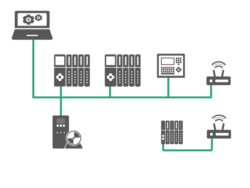 Wireless connections open up a wide variety of applications which are very difficult or impossible with regular cabling, such as automated guided vehicles (AGVs), autonomous mobile robots (AMRs), and portable control panels. PROFINET is based on standard unmodified Ethernet and can connect seamlessly with any wireless standard from IEEE 802.11 (WLAN) or IEEE 802.15 (Bluetooth). PROFINET supports WLAN and Bluetooth connections as part of its specification. Legacy networks, such as PROFIBUS, require vendor-specific or proprietary solutions for wireless communication, whereas PROFINET relies on vendor-agnostic open standards.
Wireless connections open up a wide variety of applications which are very difficult or impossible with regular cabling, such as automated guided vehicles (AGVs), autonomous mobile robots (AMRs), and portable control panels. PROFINET is based on standard unmodified Ethernet and can connect seamlessly with any wireless standard from IEEE 802.11 (WLAN) or IEEE 802.15 (Bluetooth). PROFINET supports WLAN and Bluetooth connections as part of its specification. Legacy networks, such as PROFIBUS, require vendor-specific or proprietary solutions for wireless communication, whereas PROFINET relies on vendor-agnostic open standards.
Users must choose specific hardware and a communication technology to transmit wireless signals. The following sections expand on these concepts:
Networking Hardware: Wireless Access Points
Wireless access points (WAPs) are required to transmit wireless data in a network. WAPs are networking hardware devices that allow wireless capable devices and wired networks to connect through a wireless standard. WAPs can be standalone devices or built-into other devices. For example, some PROFINET devices act as a WAP aside from their I/O functions.
WAPs have at least one antenna to radiate and collect radiofrequency energy. Generally, antennas come in two forms: omnidirectional or line-of-sight. Omnidirectional antennas radiate signals in all directions, enabling 360-degree coverage. Line-of-sight antennas radiate signals in a particular direction, reducing signal degradation between connected nodes.
Bluetooth and WLAN
Bluetooth and WLAN are wireless communication technologies that use radio waves to transmit data. Both of them are based on international standards which are continuously evolving due to consumer demands. In the consumer world, Bluetooth connects personal mobile devices, such as keyboards, printers, cell phones, and gaming controllers. WLAN, on the other hand, connects cellphones, laptops, tablets, and other mobile devices to the Internet. Due to their roles in the consumer world, Bluetooth and WLAN have different capabilities. Since they are inherently different technologies, PROFINET users must pick the most suitable one for their application requirements.
Learn more! Read this White Paper:
-Nelly Ayllon
